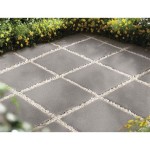How To Remove Paint From Concrete Patio
Paint spills and misplaced painting projects can leave unwanted marks on concrete patios. Removing paint from concrete necessitates patience and the employment of appropriate methods and safety precautions. The chosen technique often depends on the type of paint, the age of the stain, and the desired level of preservation for the concrete surface.
Before undertaking any paint removal project, assessing the situation is crucial. Determine the type of paint involved. Is it latex, oil-based, or epoxy? Latex paint is typically easier to remove than oil-based or epoxy paints. Also, assess the age of the paint stain. Fresh paint is generally easier to remove than paint that has been cured and bonded to the concrete for an extended period. Finally, evaluate the condition of the concrete itself. Older or more porous concrete may be more susceptible to damage during the removal process. Based on these assessments, one can select the most suitable removal method.
Safety is paramount when dealing with paint removal, as some methods involve chemicals that can be harmful. Always wear appropriate personal protective equipment (PPE), including safety glasses, gloves, and a respirator, especially when using chemical strippers. Ensure adequate ventilation in the work area, particularly if working indoors or in an enclosed space. Protect surrounding surfaces, such as landscaping and siding, with drop cloths or plastic sheeting. Dispose of all waste materials properly according to local regulations.
Key Point 1: Mechanical Removal Methods
Mechanical methods involve physically removing the paint from the concrete surface. These methods are particularly effective for thicker layers of paint or when chemical solutions are undesirable. Several mechanical methods are available, each with varying degrees of abrasiveness.
Scraping is a basic method that involves using a paint scraper to lift the paint from the concrete. This method is most effective for loose or flaking paint. A stiff-bladed scraper is generally preferred. Apply even pressure to avoid gouging the concrete surface. For larger areas, a floor scraper with a long handle can be used to improve leverage and reduce strain.
Wire brushing is another mechanical method that utilizes a wire brush to scrub away the paint. Both hand-held wire brushes and power brushes attached to drills or angle grinders can be employed. Power brushes are more efficient for larger areas but require greater control to avoid damaging the concrete. When using a wire brush, apply moderate pressure and work in overlapping strokes.
Sanding is a more abrasive method that involves using sandpaper or a sanding machine to remove the paint. Sanding is effective for smoothing out rough surfaces and removing stubborn paint residues. Start with a coarse grit sandpaper to remove the bulk of the paint, then gradually move to finer grits to smooth the surface. A concrete grinder with diamond pads can be used for larger areas and more aggressive paint removal.
Pressure washing, while often considered a cleaning method, can also be effective for removing loose or peeling paint. Use a pressure washer with a nozzle designed for concrete cleaning. Start with a low-pressure setting and gradually increase the pressure until the paint begins to lift. Be careful not to damage the concrete surface with excessive pressure. A rotary surface cleaner attachment can be used for larger areas to provide a more uniform cleaning pattern.
Shot blasting is an aggressive mechanical method that involves propelling abrasive media, such as steel shot, at the concrete surface. This method is highly effective for removing thick layers of paint and coatings but requires specialized equipment and training. Shot blasting can also roughen the concrete surface, providing a better profile for subsequent coatings.
Key Point 2: Chemical Removal Methods
Chemical paint strippers work by softening or dissolving the paint, making it easier to remove. Chemical methods are generally more effective than mechanical methods for removing paint from textured or porous concrete surfaces. However, they require careful handling and adherence to safety precautions.
Choosing the right chemical stripper is crucial. Paint strippers are available in various formulations, including solvent-based, water-based, and bio-based options. Solvent-based strippers are typically more effective at removing oil-based and epoxy paints but can be more hazardous. Water-based strippers are generally safer and more environmentally friendly but may not be as effective on tougher paints. Bio-based strippers are made from renewable resources and are considered the safest option, but their effectiveness can vary depending on the paint type and condition.
Application of the chemical stripper is critical for its effectiveness. Before applying the stripper, clean the concrete surface to remove any loose dirt or debris. Apply a thick, even layer of stripper to the painted area using a brush, roller, or sprayer. Follow the manufacturer's instructions regarding dwell time, which is the amount of time the stripper needs to remain on the surface to soften the paint. Dwell times can range from a few minutes to several hours, depending on the product and the paint type. Cover the treated area with plastic sheeting to prevent the stripper from drying out and to enhance its effectiveness.
Removal of the softened paint is done after the dwell time has elapsed. Use a scraper to remove the softened paint. For large areas, a power scraper or pressure washer can be used. Be careful not to damage the concrete surface during the removal process. If any paint residue remains, reapply the stripper and repeat the process. After removing the paint, thoroughly rinse the concrete surface with water to neutralize any remaining stripper residue. A neutralizer, such as vinegar or baking soda solution, can be used to ensure complete neutralization.
Neutralizing and rinsing are important steps after using chemical paint strippers. Neutralizing the surface helps to prevent any adverse reactions between the stripper residue and subsequent coatings or sealers. Thorough rinsing removes any remaining chemicals and debris, leaving a clean surface. Allow the concrete to dry completely before applying any new coatings or sealers.
Key Point 3: Alternative and Natural Methods
In addition to mechanical and chemical methods, several alternative and natural methods can be used to remove paint from concrete. These methods are generally less aggressive and may be suitable for small areas or when gentler approaches are preferred. However, their effectiveness can vary depending on the paint type and condition.
Baking soda blasting is a method that involves using a pressure washer to blast baking soda onto the painted surface. Baking soda is a mild abrasive that can effectively remove paint without damaging the concrete. This method is particularly effective for removing latex paint. Use a pressure washer with a media blasting attachment and follow the manufacturer's instructions.
Dry ice blasting is another method that involves using frozen carbon dioxide pellets propelled at high speeds to remove paint. The extreme cold of the dry ice causes the paint to shrink and crack, making it easier to remove. Dry ice blasting is a relatively clean and environmentally friendly method, as the dry ice sublimates into carbon dioxide gas. However, it requires specialized equipment and training.
Heat guns can be used to soften the paint, making it easier to scrape off. Hold the heat gun a few inches away from the paint surface and move it in a sweeping motion. Be careful not to overheat the paint, as this can cause it to blister or burn. Use a scraper to remove the softened paint. This method is most effective for removing small areas of paint.
Vinegar is a natural acid that can help to soften paint. Soak a cloth or sponge in vinegar and apply it to the painted area. Allow the vinegar to sit for several minutes, then scrub the area with a brush or scraper. Repeat the process as needed. Vinegar is most effective for removing latex paint.
Citrus-based cleaners are another natural alternative to chemical paint strippers. These cleaners contain solvents derived from citrus fruits, such as oranges and lemons. Citrus-based cleaners are generally less toxic than traditional chemical strippers. Apply the cleaner to the painted area and allow it to sit for the recommended dwell time, then scrub the area with a brush or scraper.
Following any paint removal process, thorough cleaning of the concrete surface is essential. Use a pressure washer or scrub brush and a mild detergent to remove any remaining residue. Rinse the surface thoroughly with water and allow it to dry completely before applying any new coatings or sealers. Inspect the concrete for any damage and repair as needed.

How To Remove Old Paint From Concrete Without Chemicals

How To Remove Paint From Concrete Vintage Revivals

How To Get Paint Off Concrete 3 Ways Remove From Paving

How Do You Remove Paint Spots Drips From Concrete Inspirations

How To Remove Paint From Concrete

How To Remove Sealer Or Paint Off A Concrete Patio
Best Way To Remove Paint From Concrete Porch Diy Home Improvement Forum

How To Remove Paint From Concrete 4 Ways That Actually Work Home Repair Geek

Remove Paint With Pressure Washing Using These Tips

How To Remove Paint From A Concrete Floor In Your Home 2024
Related Posts








